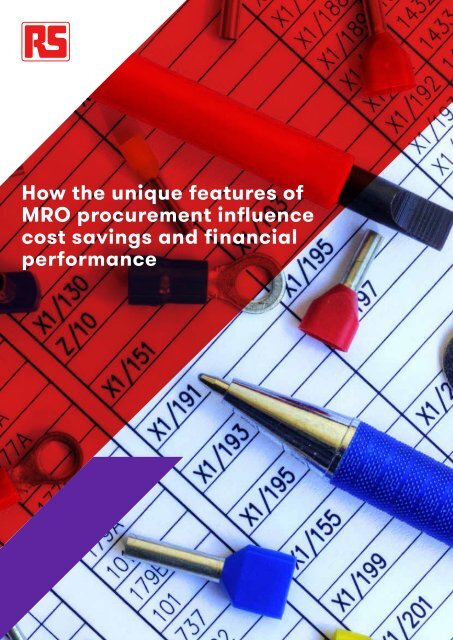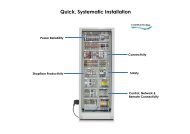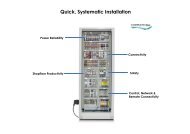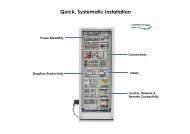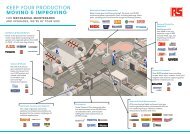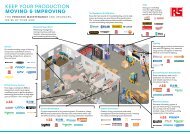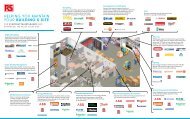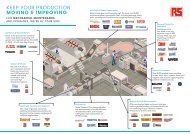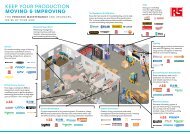MRO implications
Create successful ePaper yourself
Turn your PDF publications into a flip-book with our unique Google optimized e-Paper software.
How the unique features of<br />
<strong>MRO</strong> procurement influence<br />
cost savings and financial<br />
performance
White paper<br />
<strong>MRO</strong> Implications<br />
Unlike direct costs, the ‘hidden’ and often<br />
uncontrolled nature of <strong>MRO</strong> procurement<br />
costs can make it difficult to apply cost saving<br />
strategies. By its very nature, <strong>MRO</strong> is diverse,<br />
fragmented and unplanned; consequently many<br />
organisations choose not to pursue cost savings<br />
in this area, or simply don’t know how to go about<br />
it. Yet the potential for financial savings and<br />
efficiency gains is substantial.<br />
This white paper, one of a series covering best<br />
practice in <strong>MRO</strong> Procurement, discusses the<br />
true nature of <strong>MRO</strong> procurement and explores<br />
what it means for an organisation in terms of<br />
cost savings, financial performance and profit<br />
improvement.<br />
rs-connectedthinking.com<br />
connectedthinking@rs-components.com
White paper<br />
<strong>MRO</strong> Implications<br />
Introduction<br />
According to a GEP study in 2011, some of the<br />
main reasons that <strong>MRO</strong> typically affects an<br />
organisation’s profitability adversely are:<br />
• Large spend spread out over many different<br />
sites and categories.<br />
• A large number of SKUs. A Fortune 100<br />
manufacturing operation may require 25,000<br />
to 50,000 unique <strong>MRO</strong> SKUs, which are only<br />
used in certain equipment.<br />
• Unpredictable demand for <strong>MRO</strong> items. Some<br />
<strong>MRO</strong> items may turnover less than once every 2<br />
years.<br />
• ‘Just in case’ mentality – ‘I can’t afford to wait<br />
for this part so I’ll buy some now just in case’.<br />
• A large number of suppliers.<br />
• Decentralised <strong>MRO</strong> processes: sourcing,<br />
request/order, inventory management with<br />
inconsistent practices and processes.<br />
• Maverick spend, due to lack of process control.<br />
• Spot buys – unplanned purchases for items not<br />
set up in inventory – can account for as much<br />
as 50% of annual spend.<br />
• Data management across sites is a challenge.<br />
• Part level information is typically inconsistent<br />
and incomplete.<br />
• No common part numbering scheme, so the<br />
same item is identified in many different ways.<br />
Reducing costs disproportionately improves financial performance<br />
All of these factors can be addressed individually<br />
through various cost saving tactics, but sustained<br />
cost saving success becomes extremely difficult to<br />
achieve without three key components: involvement<br />
of key decision makers, proper tracking of savings<br />
and utilisation of data analytics.<br />
A 1% decrease in total costs can have the same<br />
effect as a 10 times or more increase in a company’s<br />
total revenues. To put this revenue increase into<br />
perspective, a company would have to achieve close<br />
to 60% compound annual revenue growth over five<br />
years to achieve the 10 times revenue increase.<br />
Once the key personnel are engaged and the<br />
correct processes are being utilised, an organisation<br />
can start to achieve sustained cost savings in <strong>MRO</strong><br />
which can lead to huge increases in a company’s<br />
earnings before interest and taxes, and can free<br />
cash flow.<br />
rs-connectedthinking.com<br />
connectedthinking@rs-components.com
White paper<br />
<strong>MRO</strong> Implications<br />
Cost saving areas and the potential for savings<br />
There are 4 main areas of costs to focus on:<br />
product costs, inventory costs, purchasing costs,<br />
sourcing costs. Here we outline the potential for<br />
savings within each area.<br />
1. Product costs<br />
The cost saving that companies can achieve by<br />
focusing exclusively on product discounting is<br />
limited. The buyer can usually only save 3-4%<br />
of product costs, or potentially 10% at best, by<br />
negotiating with vendors or through competitive<br />
bidding. This is because there is limited scope for<br />
discounting by <strong>MRO</strong> suppliers, who typically have<br />
very thin margins.<br />
‘On average, product costs only make up 20%<br />
of total <strong>MRO</strong> costs, while the rest are all the<br />
processing costs that would not be shown on the<br />
invoice.’ 1<br />
So <strong>MRO</strong> product cost saving has to be sought<br />
from alternative methods such as changes in<br />
purchasing criteria – brand selection, product<br />
standardisation and consolidation and better<br />
strategic procurement planning.<br />
Brand substitution – Although some <strong>MRO</strong><br />
products are purchased for advanced purposes,<br />
sometimes less expensive products could be<br />
substituted with comparable or equivalent results.<br />
Brand substitution could be considered for<br />
original equipment manufacturer’s parts (OEM)<br />
which are typically much more expensive than<br />
their generic counterparts.<br />
Consumption analysis – For companies with<br />
multiple sites in particular, <strong>MRO</strong> product costs<br />
could be reduced by tracking consumption at<br />
a <strong>MRO</strong> unit level at each of the locations and<br />
comparing their usage. Data could then be<br />
shared across the locations, and volumes of<br />
products cut where necessary. This practice could<br />
also optimise the usage of <strong>MRO</strong> items.<br />
Product standardisation – If companies<br />
compare their products across different<br />
departments and / or sites, <strong>MRO</strong> product costs<br />
could be reduced by standardising products and<br />
equipment. Product family consolidation could<br />
also be utilised to rationalise materials purchased<br />
across sites and departments - particularly when<br />
materials within the same product family come<br />
from several different suppliers. This also helps<br />
to minimise the learning curve and speed up<br />
production 2 .<br />
Procurement planning – Cost savings could<br />
also come from better planning in procurement<br />
management. Unplanned <strong>MRO</strong> procurement<br />
purchases typically represent a large percentage<br />
of ‘spot buys’ – unplanned purchases are<br />
typically more than 40% 3 . The majority of these<br />
unplanned purchases are sourced through a large<br />
number of suppliers and across many different<br />
products. The implication of this is that these spot<br />
buys increase the costs of managing the ordering<br />
process and add risk to maverick spending. A<br />
reduced supplier base leaves the buyer more<br />
time to develop better relationships with trusted<br />
suppliers and maximise purchasing power as well<br />
as reducing sourcing and processing time.<br />
rs-connectedthinking.com<br />
connectedthinking@rs-components.com
White paper<br />
<strong>MRO</strong> Implications<br />
2. Inventory costs<br />
‘The vast majority of organisations pay little or<br />
no attention to <strong>MRO</strong> inventories, other than to<br />
replenish stocks that have run low. The reason<br />
for this inattention is that almost all enterprises<br />
expense their <strong>MRO</strong> purchases through the profit<br />
and loss statement, rather than capitalising <strong>MRO</strong><br />
inventories – as they do for raw materials, work-inprocess,<br />
finished goods or capital equipment – on<br />
their balance sheets.’ 1<br />
Research by the Aberdeen Group argues that<br />
inventory is one of the most valuable assets, yet<br />
companies fail to manage it effectively.4<br />
There are many factors to consider when<br />
discussing inventory and associated costs:<br />
20% to 50% or more of <strong>MRO</strong> stocks (in dollar<br />
value) are typically surplus or dead inventory. 1<br />
Annual cost of carrying unneeded inventory<br />
typically averages about 18% of purchasing<br />
costs. Purchase costs include interest (cost<br />
of money), space, record keeping, loss and<br />
obsolescence, insurance, property taxes,<br />
handling, disposal etc. 1<br />
Companies that try to reduce inventory across<br />
the supply chain are twice as likely to have belowaverage<br />
inventory carrying costs. 4<br />
Supply chain inventory initiatives drive more than<br />
20% reduction in on-hand inventory and more<br />
than 20% improvements in time-to-market in a<br />
case of best-in-class companies (Aberdeen Group<br />
2004). However, a 2005 UPS study argues that<br />
successful initiatives identify excess inventory<br />
of 4% to 10% excluding inventory allocated to<br />
provide increased service levels.<br />
Most companies do not believe that there is<br />
an <strong>MRO</strong> inventory problem, and those that do<br />
assume that nothing can be done about it. 1<br />
Consigned Inventory – Companies could<br />
eliminate most or all of their inventory by<br />
implementing consigned inventory with their<br />
supplier, since under these conditions the supplier<br />
owns the inventory until they use it.<br />
Vendor-managed inventories – By implementing<br />
a vendor-managed inventory, a company could<br />
save money in process costs because the supplier<br />
would determine the inventory and process the<br />
procurement transactions. This solution could<br />
work if the supplier can provide greater inventory<br />
control and management than the customers<br />
currently do themselves.<br />
Inventories transfer and disposal – Research<br />
by the Aberdeen Group in 2004 suggests that<br />
companies have an inventory misconception<br />
that it is fine for each location or tier in the<br />
supply chain to set its own level targets and<br />
replenishment frequencies. This might be as a<br />
result of lack of synchronised inventory policies<br />
across the supply chain, By implementing<br />
inventories transfer and disposal, one company<br />
could reduce the amount of non-working <strong>MRO</strong><br />
inventories by utilising a different company site<br />
which does use them, thereby saving money and<br />
making all sites more efficient.<br />
Brand substitution – Companies could also<br />
reduce the value of stock by stocking products<br />
that are worth less. However, lower price products<br />
could mean lower quality – the company<br />
should think carefully before replacing the<br />
product, especially if it is specific or critical to<br />
maintaining the company’s operation.<br />
UPS in 2005 suggest that the right mixes of<br />
current inventory, elimination of old and obsolete<br />
inventory, tight integration with demand planning<br />
and identification of appropriate safety stock<br />
targets can lead to even higher levels of service.<br />
There are several possible ways to save money by<br />
managing inventory efficiently.<br />
rs-connectedthinking.com<br />
connectedthinking@rs-components.com
White paper<br />
<strong>MRO</strong> Implications<br />
3. Purchasing costs<br />
Purchasing costs cover the core purchasing<br />
processes, such as: identifying the need, the<br />
raising of requisitions, route approval, creation of<br />
purchase orders, receiving goods and matching<br />
invoices.<br />
Direct purchases account for 20% of total<br />
numbers of purchase orders, yet indirect<br />
purchases account for 80% of total numbers of<br />
purchase orders.5 (Figure 01).<br />
Although companies may have standardised their<br />
direct materials, <strong>MRO</strong> procurement systems tend<br />
not to be standardised. This is because in general<br />
when companies purchase direct materials, a<br />
procurement division controls the orders. When it<br />
comes to indirect or <strong>MRO</strong> materials, procurement<br />
divisions cannot manage them efficiently because<br />
those processes are outside standardised<br />
procurement and financial management systems.<br />
Supplier reduction – Consolidation of spend<br />
to larger, more flexible suppliers can eliminate<br />
managing multiple negotiations and suppliers.<br />
E-procurement solutions – Offer a reduction in<br />
purchasing costs - automated purchase orders, or<br />
blanket purchase orders can be set up, ordering<br />
directly from supplier websites, automated invoice<br />
matching.<br />
4. Sourcing costs<br />
Sourcing costs are similar to purchasing costs,<br />
but also include spend analysis, demand<br />
management, contract negotiation and contract<br />
management.<br />
All of these areas are difficult to manage for <strong>MRO</strong><br />
because of the large proportion of unplanned<br />
and non-standard items and the large volume of<br />
suppliers.<br />
Direct and indirect spend<br />
Implication<br />
FIGURE 01<br />
Indirect<br />
purchase<br />
spend (20%)<br />
Direct<br />
purchase<br />
spend (80%)<br />
By misunderstanding the true nature of <strong>MRO</strong><br />
procurement, and by overly focusing on achieving<br />
product discounts, organisations actually<br />
limit their scope to gain savings in <strong>MRO</strong>. Such<br />
savings have an impact on the organisation’s<br />
financial performance and contribute positively<br />
to its profitability, so they are important for the<br />
organisation to realise.<br />
rs-connectedthinking.com<br />
connectedthinking@rs-components.com<br />
References:<br />
1. Roth, 2008; 2. Bragg, 2010; 3.<br />
Campbell, 2006; 4. Aberdeen Group,<br />
2004; 5. Hawking, 2004;
White paper<br />
<strong>MRO</strong> Implications<br />
Conclusion<br />
As it is such a major component of an<br />
organisation’s procurement costs (47%), and as<br />
it has unique characteristics, <strong>MRO</strong> procurement<br />
needs a deeper understanding and a refocus.<br />
With process costs representing as much<br />
as double the average product costs, <strong>MRO</strong><br />
process costs can present a great opportunity<br />
to realise significant cost savings, through<br />
various acknowledged procurement improvement<br />
strategies. This, along with the understanding that<br />
<strong>MRO</strong>, through its unplanned nature, is different<br />
from direct procurement, leads to a conclusion<br />
that <strong>MRO</strong> procurement strategy needs to have<br />
a different and an equal focus in cost saving<br />
strategies. The various cost saving strategies will<br />
be covered in our forthcoming white papers.<br />
Methodology<br />
Manchester Business School (MBS) is the UK’s<br />
largest campus-based business and management<br />
school. The school is ranked first in the UK for<br />
business research and their original thinking<br />
is applied across business and management,<br />
government and communities worldwide.<br />
In a broad-ranging project, RS Components has<br />
worked with MBS to identify and evaluate industry<br />
best practices in realising generic cost savings<br />
strategies. The project also had an objective<br />
of determining the cost-drivers associated with<br />
<strong>MRO</strong> procurement in companies, with the goal of<br />
identifying the percentage of processing costs to<br />
product costs within total product procurement<br />
costs.<br />
The project methodology included primary and<br />
secondary research. Interviews with Academics<br />
from the University of Manchester and industry<br />
Subject Matter Experts (SMEs) related to <strong>MRO</strong><br />
procurement and also a web survey formed part<br />
of the primary research. The secondary research<br />
phase involved studying materials related to the<br />
project in the form of white papers, published<br />
papers, articles, other professional publications,<br />
the MBS library databases, internet sources and<br />
information shared by RS during client meetings.<br />
RS Components are committed to developing<br />
procurement strategies to help businesses save costs,<br />
improve efficiency and effectiveness. Our experience and<br />
global scale position us as an industry leading provider.<br />
For more information contact your RS Account Manager<br />
or email connectedthinking@rs-components.com.<br />
No part of this publication can be reproduced wholly or in<br />
part without the express written permission of<br />
RS Components Ltd.<br />
RS Components Ltd. Birchington Road,<br />
Corby, Northants NN17 9RS, UK<br />
rs-connectedthinking.com<br />
connectedthinking@rs-components.com


